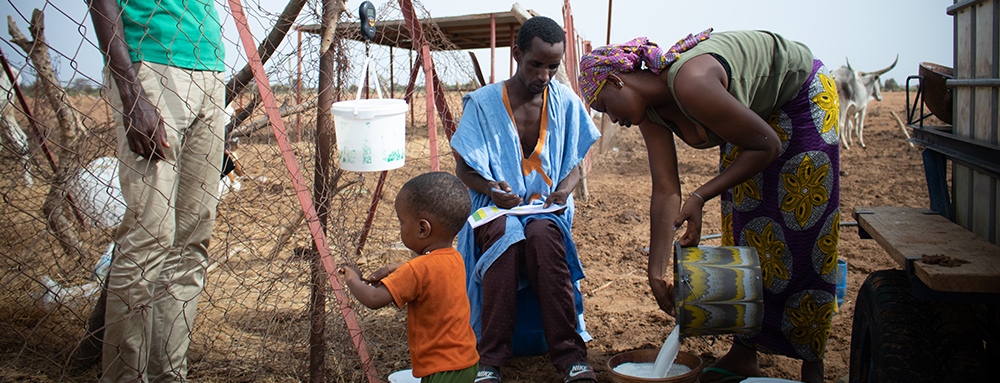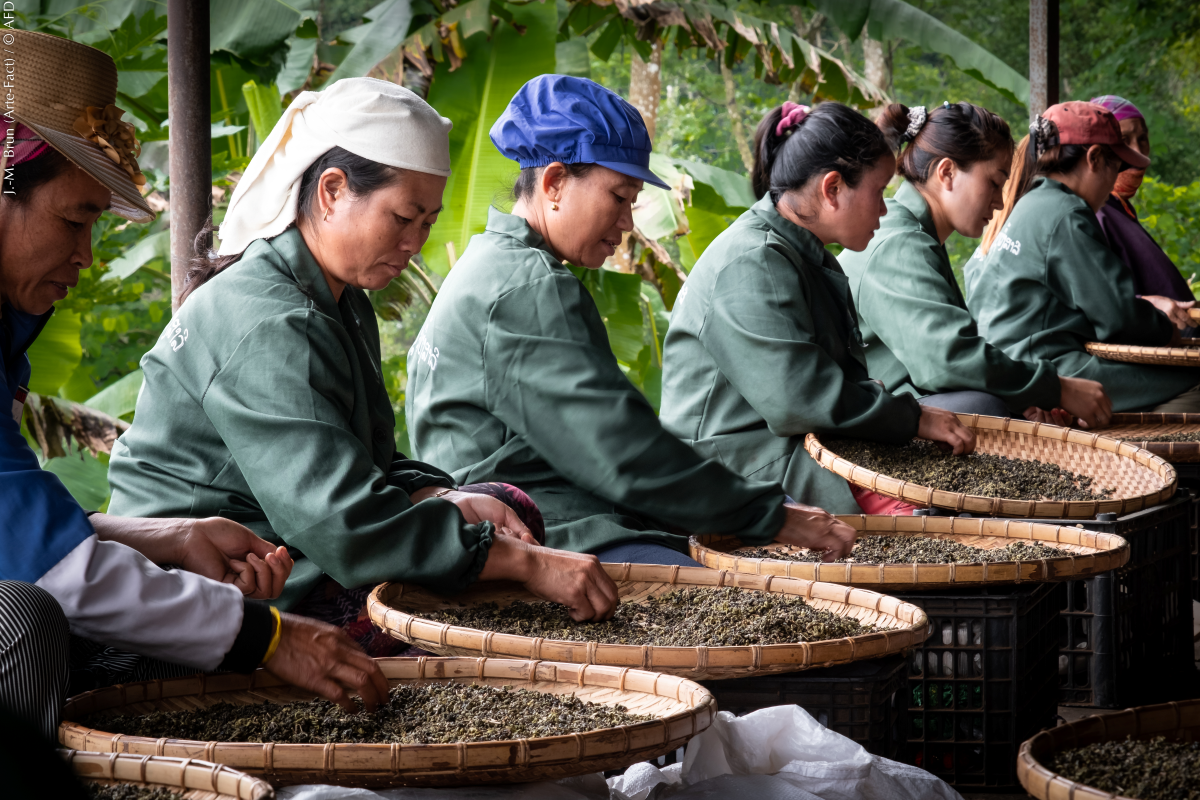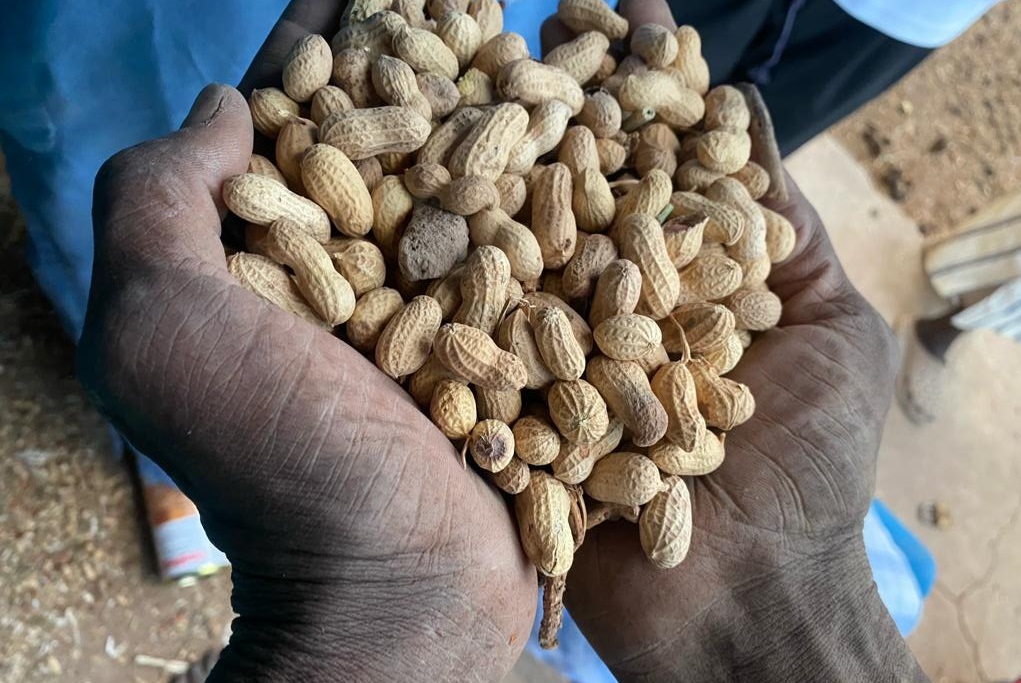In the north of Senegal, GRET and its partners are supporting structuring of the milk sector and striving to improve living conditions for family livestock farmers. Down through the years, the Asstel project enabled the emergence of promising evolutions and dynamics that must now be made sustainable…
The Dagana region, in the north of Senegal, is marked by an intensive livestock farming system, with milk sales making it possible to cover 25 % of food requirements, in an area where 55% of households are affected by food insecurity. In 2006, the Berger Dairy (in French only), an industrial milk processing company, was set up in Richard-Toll. The latter revitalised the development of milk production in the Dagana region, providing a real opportunity in terms of market outlets for family farms.
Previously, livestock farmers had to deal with difficult climate conditions (in particular highly variable rainfall and difficulties feeding and watering livestock), and often had no choice but to travel very early for transhumance to the Ferlo and Sine Saloum regions during the dry season in order to ensure survival of livestock. This transhumance led to a decrease, if not a stoppage, in production and sale of milk. This was compounded by the problem of profitability of milk, which was sold exclusively on local markets.
From a sectoral to an integrated territorial approach
The first phase of the Asstel project (in French only), implemented by GRET and its partners from 2012 to 2015, focused on the development of milk production. It responded to several issues, in particular structuring of collection circuits – making it possible to ensure supply of the Berger Dairy – and an increase in the level and regularity of livestock farming families’ incomes. This first phase also marked the beginning of multi-stakeholder and interprofessional dialogue at regional level.
Assessment of the project, conducted with communities, highlighted other needs, such as strengthening of services provided to farms (feed products, forage and collection), and support for economic activities conducted by women and young people to diversify sources of income.
2016 saw the start of the second phase of the project (in French only), aiming to make the changes initiated sustainable, to the extent of observing changes in livestock farming practices and milk production at “Pilot Farm” (PF) network level. This stage also made it possible to launch some great socio-economic initiatives, focusing on diversification of activities, correlated to the implementation of the relay village facilitation system and the literacy training programme.
A satisfactory overall assessment to be consolidated
Evolving production practices and livestock farming systems
Despite a rather difficult territorial context, testing of technical-economic models for production and livestock farming via a scheme providing advice to family farms – demonstrated that developments in livestock farming practices and systems are really possible. At PF network level, the latter have led to:
- the creation and stabling of a core dairy herd, comprising between 4 and 14 dairy cows;
- storage of fodder and concentrate feed;
- management by farmers of feed rationing for the dairy herd, combined with their capacity to write (feed and milk weighing data);
- an increase in milk production, especially in the dry season, from 1.5 litres to 3.5 litres per cow per day.
This increase in production during the dry season has become a trend since 2018. Faced with increasingly catastrophic overwintering, the pilot livestock farms are planning dairy herd feed requirements: this demonstrates a capacity to anticipate. These changes in practices and systems are all the more important as the price per litre of milk supplied to the Berger Dairy is becoming more remunerative. In February 2018, the dairy increased the price from 225 to 320 CFA francs per litre, following the Senegalese government’s exemption of VAT on pasteurised milk.
Promising initiatives to strengthen the resilience of family farms
In order to provide a response to the demand for better inclusion of women in the project, the focus was placed on the development of actions likely to improve their social and economic situation, particularly regarding literacy training and diversification of economic activities. Although the results and effects of literacy training were quickly observed, those relating to economic initiatives were not fully visible before the end of the project. The trainees, made up mainly of women, manage milk production and other economic activities better using management tools translated into Pulaar. In addition to this, there has been a considerable evolution in terms of women speaking in public during meetings and events, even when these are mixed. With regards economic initiatives, the initial results of gross margin monitoring demonstrate:
- interesting activities, such as milk processing, cereal processing and fattening;
- low-remuneration activities: small-scale trade and soap-making;
- a strong interest in market-gardening, which is a recent activity.
The village savings and credit associations system that was developed was not only a means for funding women’s economic activities, it also provided a framework for regular meetings to discuss subjects they are interested in, which made it possible to strengthen social ties.
It is important to note that all these evolutions and initiatives were supported in parallel by the implementation of a relay village facilitation scheme, an innovation making it possible to drive village development initiatives.
Forums of consultation that have to be strengthened
In order to foster interprofessional and territorial consultation, the Milk Innovation Platform (PIL) was boosted. A sectoral livestock farming sub-commission (SCSE) was also set up in Dagana. Through its mission, which consists of “facilitating sustainable development of business relationships between local milk value chain stakeholders through innovations, with a view to its dynamic and inclusive emergence”, GRET worked together with PIL to enable livestock farmers to have access to services supporting structuring of the milk sector (feed, fodder and collection). Nevertheless, if the latter is to function in a much more inclusive manner, it must set up a regular facilitation system and develop strategies for raising capital while guaranteeing member satisfaction upstream. As for the SCSE, its mission is to provide a tribune to generate discussion, conduct reflection and deliver information for the formulation, implementation and evaluation of intervention policies and strategies for sustainable development of the livestock farming sector. This is why, together with the Dagana Regional Council and under the coordination of the Regional Development Agency (ARD), it led the process for drawing up a Regional livestock farming development plan. This forum for multi-stakeholder dialogue also presents issues around strengthening of facilitation and the search for resources necessary to enable its functioning.
Results highlighted at the 3rd edition of the international symposium on “milk, a vector for development”
This event, organised in Dakar by ISRA (Senegal), Cirad (France) and INRA (France) on the 12 and 13 June last, was an opportunity for GRET to present – in the form of a poster – the ways in which the scheme providing advice to family dairy farms affected the evolution of milk production practices. The local milk collector guide was also presented at the innovations fair.
In light of all this, the main challenge today is the continuation of evolutions, changes and initiatives, with a view to making achievements sustainable and ensure social transformation over the long term. This is why the third phase of Asstel, which began in September 2019 and will last 40 months, aims to be a phase of consolidation and transfer of skills to local stakeholders.






